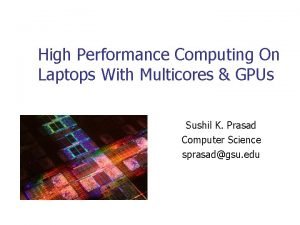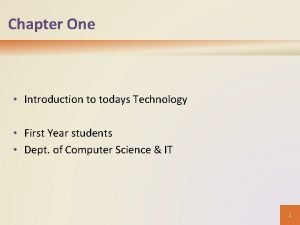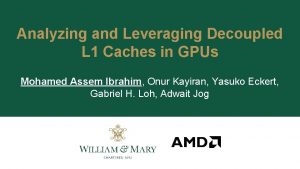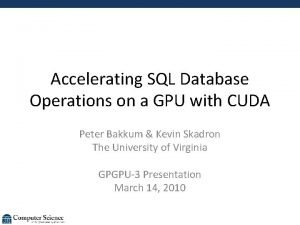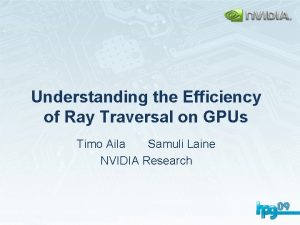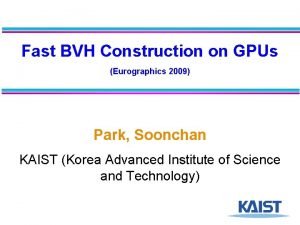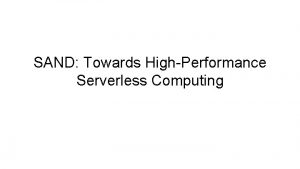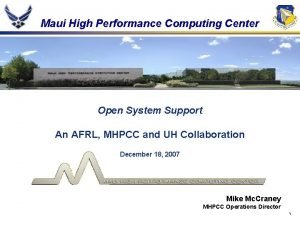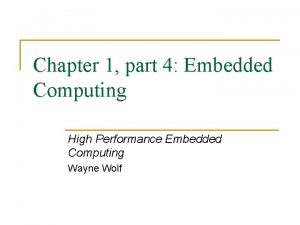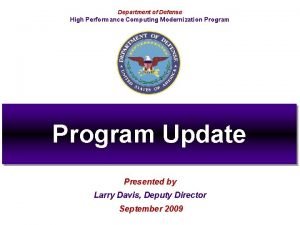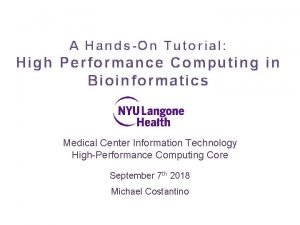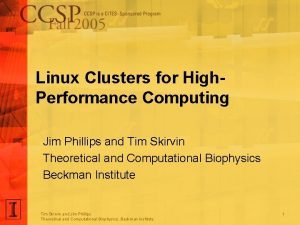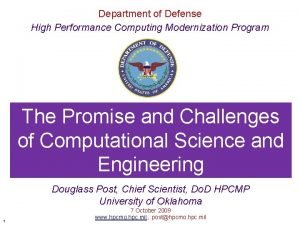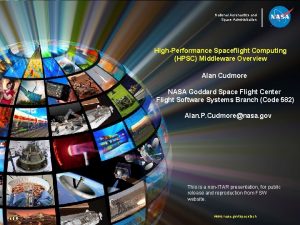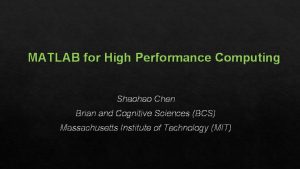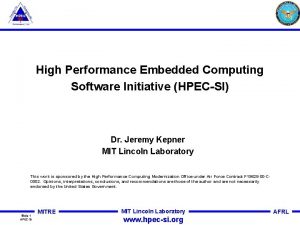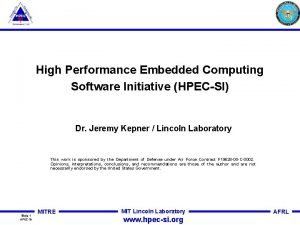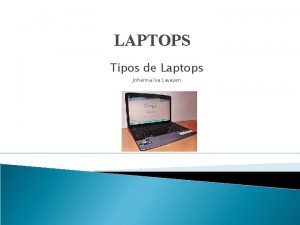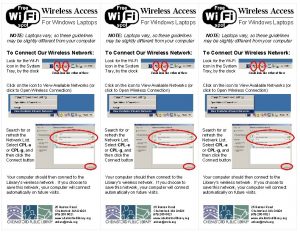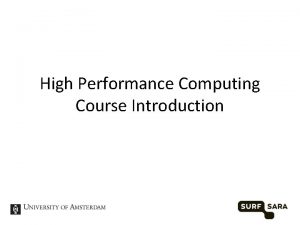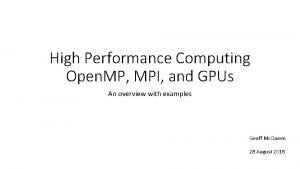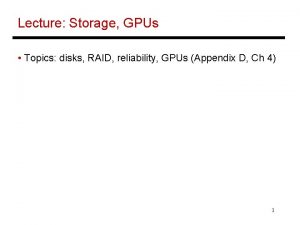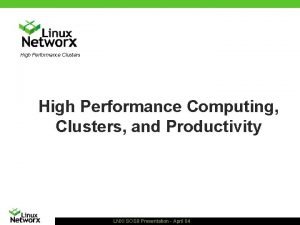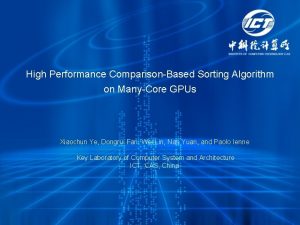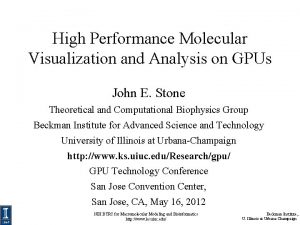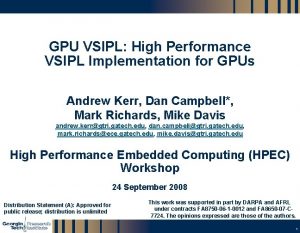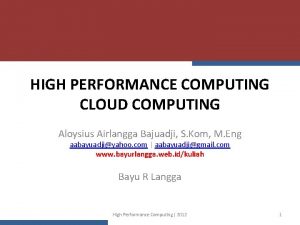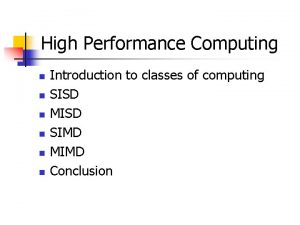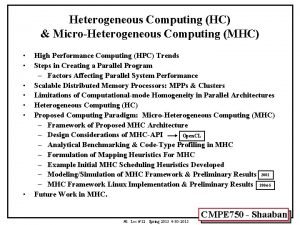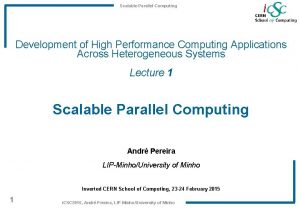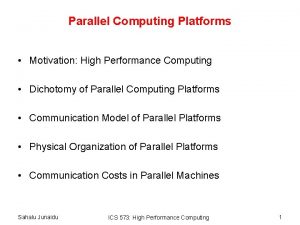High Performance Computing On Laptops With Multicores GPUs


















- Slides: 18

High Performance Computing On Laptops With Multicores & GPUs Sushil K. Prasad Computer Science sprasad@gsu. edu

About me Research Area: Parallel and Distributed Algorithms and Systems - over multicores, GPUs, clusters, sensors, handhelds, web services, … Lab: n n Distributed and Mobile Systems (Di. Mo. S) at Ga. Tech campus, 5 Ph. D students, 2 M. S. students IEEE TCPP Chair (elected) 2 NSF grants – currently looking for Ph. D/MS/undergraduate students n n Distributed Algorithms High Performance Cloud Computing

Multicore & GPU Chips Inside a Laptop - 100 s of processors

GPUs Vs Multicores • Combined power exceeds 180 GFLOPs

Intel Core-2 Duo Multicore n n Difficult to parallelize Memory hierarchy is a barrier: n n 1 cycle core 3 cycles L 1 cache 14 cycles L 2 250 cycles RAM

GPU: Graphics Processing Unit Nvidia 280 GTX • 240 cores • Extreme memory hierarchy • • • Registers Local memory Shared memory/8 cores Off chip Global Memory bottleneck bus to CPU

• Nvidia 8800 GTX • Smith Waterman Seq Alignment, Fasta, and Blast • Database: Swiss. Prot • Manavski and Valle 2008

Parallel Data Structures Priority Queues • Large Scale Event Simulation • Immune System Simulation 5 3 1 2 • VLSI Logic simulation • Branch and Bound • Task Scheduling • Challenge: Fine Grained Systems • Students: Dinesh Agarwal, Nick Mancuso 10 12 6 15 8 7 9 6 16 13 5 14 65 8 23 34 25 38 9 19 7 21 12 14

Parallel Priority Queues on Multicore

Legacy-Code to GPUs (Student: Chad Christopher)

Distributed Algorithms for Lifetime of Wireless Sensor Networks (Student: Akshaye Dhawan)

NP-Hard Distributed Problems in Networks NSF Grant n n n Minimum Vertex/Target Cover Minimum Triangle Packing Optimum mobile sensor network target tracking Minimum channel assignment in mobile adhoc networks Students: John Daigle, Thamer Sulaiman

Middleware for Mobile Ad–hoc Applications Mobile Support Station Applications 3. p 2 p communication Process Requests Deviceware Listener Applications 2. Lookup 1. Register Listener Process Requests Deviceware Listener Groupware 10 September 2020 UM-Morris Directory 13

Bond. Flow: Distributed Workflow over Web Services (Student: Janaka Balasooriya) Web Services Registry (UDDI) S O A P Lookup for Web services WSDL Web Service Interface Module WS Locator WSDL Parser § Web service interface module § Proxy object generator module Parsed WSDL Workflow Execution Module Proxy Object Generator Module Web Bond Runtime SOAP/ Sy. D JVM Workflow Configuration Module § Workflow configuration module § Execution module. § Mobile Web Services

P 2 P Search based on Bayesian Decision and Value of Information (VOI) – (Student: Rasanjalee) Peer Selection: n n n A Priori Uncertainty : U 1 Sending/forwarding query at each node along query path = series of decision making steps based on incomplete data A decision step: query the node that will reduce the uncertainty of current belief most. A Posterior Uncertainty : U 2 U 1 –U 2 = Information The reduction in uncertainty at each decision step Decision step 1. . Decision step n Experimental Results: Success Ratio Success ratio % n The meaning of Uncertainty based Information 100 90 80 70 60 50 40 30 20 10 0 SR-APS SR-UCBPS 1 2 3 # walkers 4 5 Current Belief. .

Middleware on Distributed Smart Cameras n Middleware on DSC networks n n provide a high-level programming interface for applications. simplify the development of distributed applications on DSC networks. provide networking functionality as part of the middleware Student: Jayampathi Sampat cmucam 3

About me Research Area: Parallel and Distributed Algorithms and Systems - over multicores, GPUs, clusters, sensors, handhelds, web services, … Lab: n n Distributed and Mobile Systems (Di. Mo. S) at Ga. Tech campus, 5 Ph. D students, 2 M. S. students IEEE TCPP Chair (elected) 2 NSF grants – currently looking for Ph. D/MS/undergraduate students n n Distributed Algorithms High Performance Cloud Computing

High Performance Computing On Laptops With Multicores & GPUs Sushil K. Prasad Computer Science sprasad@gsu. edu
 Laptops for high performance computing
Laptops for high performance computing Best laptops for genealogy
Best laptops for genealogy Differentiate among laptops tablets desktops and servers
Differentiate among laptops tablets desktops and servers Difference between chromebooks and laptops
Difference between chromebooks and laptops Analyzing and leveraging decoupled l1 caches in gpus
Analyzing and leveraging decoupled l1 caches in gpus Gpu sql
Gpu sql Understanding the efficiency of ray traversal on gpus
Understanding the efficiency of ray traversal on gpus Sah bvh
Sah bvh Sand: towards high-performance serverless computing
Sand: towards high-performance serverless computing Maui high performance computing center
Maui high performance computing center High performance embedded computing
High performance embedded computing High performance computing modernization program
High performance computing modernization program Big purple nyu
Big purple nyu High performance linux clusters
High performance linux clusters High performance computing modernization program
High performance computing modernization program Hpsc nasa
Hpsc nasa Matlab high performance computing
Matlab high performance computing High performance embedded computing
High performance embedded computing High performance embedded computing
High performance embedded computing
